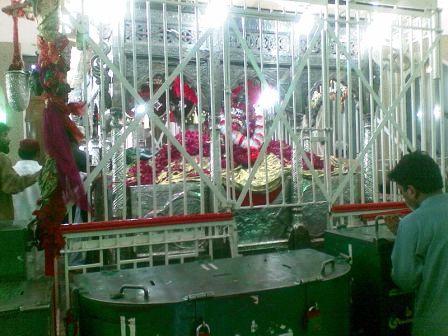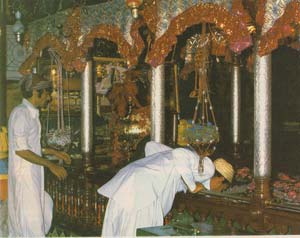The Red Falcon

Centuries ago, the Qalandar mystics emerged as a separate movement of Sufism with a distinctive style of dress and behaviour. Shaykh Jamaluddin and Hasan al Jawaliqi of Iran rank among the celebrated Qalandars. Bu Ali Shah Qalandar of Panipat migrated from Iraq to India. Lal Shahbaz Qalandar of Sindh is another famous Qalandar of the subcontinent.
One of the most popular qawaalis of the subcontinent ‘Dam a dam mast qalandar, Ali da pehla number, sindhdi da, sehwan da, Sakhi Shahbaz Qalandar’, invokes the name of the Sindhi Sufi Lal Shahbaz. The verse demonstrates the mystic’s deep love for Imam Ali which is inscribed on his grave: ‘I am a Haidari, Qalandar and intoxicated, I am a slave of Ali Murtaza, I am a leader of those intoxicated with love, For I am a dog of the lane of “Allah’s Lion”. ’
The Hindus lovingly address Lal Shahbaz as ‘ Jhule Lal’, Lord of the Indus River. Even now at the annual Urs, one of the old caretakers is a Hindu, who performs the inaugural ritual for the annual festivities. Despite the partition of India, the environment of Sehwan Sharif is an extraordinary demonstration of Hindu -Muslim syncretism, an aspect particular to South Asian Islam.
Lal Shahbaz’s real name was Sayyid Usman Shah but he acquired the title of Lal, red, due to his habit of wearing red garments, and Shahbaz, royal falcon, for his soaring divinity. Some legends attribute the title to miracles such as taking spiritual flights to Makkah for prayers at the Kaabah. Another tale recounts how he flew to help his friend Bahauddin Zakariya whose life was threatened by the King of Multan.
Born to the mystic Syed Ibrahim Kabiruddin, Lal Shahbaz’s family drew their lineage from Imam Jafar Sadiq, a descendant of Imam Ali. The family came from Sistan, an Iranian province that borders Afghanistan and Pakistan.
The mystic was born at Marwand, a town in Afghanistan. The family migrated to Mashad in Iraq before returning to Marwand. At Mashad, Lal Shahbaz is said to have meditated continuously at the famous tomb of Imam Ali Reza for forty days and nights.
During his journey to the subcontinent, Lal Shahbaz stayed at the Panjgur valley of Makran, Baluchistan. The place later became known as Dasht-e-Shahbaz, where many Baluch tribesmen became his followers. The Mughal emperor Babar mentions the area in his autobiography, Tuzuk-e-Baburi.
Overwhelmingly adored alike by Hindus and Muslims of Sindh, Lal Shahbaz arrived in Multan in 1263. The people of Multan besought him to stay but he continued his journey southward, eventually settling in Sehwan, a famous center of learning. Sehwan was known for its splendour and sanctity as a sacred place for Hindus of Sindh. The earlier name for Sehwan was Sivistan, the city of lord Shiva.Lal Shahbaz settled on the outskirts of the town for six years during which he provided spiritual guidance to thousands of people.
Lal Shahbaz lived during the age of the famous Chishti Sufi Baba Farid of Ajodhan, Shaykh Bahauddin Zakariya of Multan, and Jalauddin Bukhari of Uch. They were all close friends and came to be called ‘ chaar yaar’, the four companions’.
Lal Shahbaz claimed to be the spiritual disciple of Mansur Hallaj, the tenth-century martyred mystic poet of Baghdad. He lived at the site of an old Shiv temple on the west bank of the Indus. He made his home in a hollow tree trunk where he performed his ascetic exercises. The area, now a walled garden is known as Lal Bagh, whose sweet water springs that irrigate it are attributed to the miracles of Lal Shahbaz.
Looking for blame and humiliation that is typical of the Qalandars, Lal Shahbaz then moved into the brothel area of Sehwan. This move of the mystic shocked the religious orthodoxy. It is believed that all the sex workers left their brothels and became his disciples. He encouraged his followers to use dance as a way of achieving spiritual ecstasy, a tradition still followed at his dargah in Sehwan Sharif with the accompanying of dhamaal, the beating of drums.
A stunning mausoleum with Sindhi tiles, mirror work and gold plated doors stands over his grave.
An erudite scholar, Lal Shahbaz was fluent in Arabic, Persian, Sanskrit and Sindhi. Several books in Persian and Arabic poetry and on philology are attributed to him. All the later Sindhi mystics including Shah Abdul Latif Bhitai, Makhdoom Bilawal, Sachal Sarmast and Qadir Bukhsh Bedal were devout followers of Lal Shahbaz Qalandar. ?He died on the 18 Shaban 673 Hijri/ 1274 AD. A stunning mausoleum with Sindhi tiles, mirror work and gold plated doors stands over his grave.
The Hindus lovingly address Lal Shahbaz as ‘ Jhule Lal’, Lord of the Indus River. Even now at the annual Urs, one of the old caretakers is a Hindu, who performs the inaugural ritual for the annual festivities. Despite the partition of India, the environment of Sehwan Sharif is an extraordinary demonstration of Hindu -Muslim syncretism, an aspect particular to South Asian Islam.
-
Book Shelf
-
 Book Review
DESTINY OF A DYSFUNCTIONAL NUCLEAR STATE
Book Review
DESTINY OF A DYSFUNCTIONAL NUCLEAR STATE
- Book ReviewChina FO Presser Where is the fountainhead of jihad?
- Book ReviewNews Pak Syndrome bedevils Indo-Bangla ties
- Book Review Understanding Vedic Equality….: Book Review
- Book Review Buddhism Made Easy: Book Review
- Book ReviewNews Elegant Summary Of Krishnamurti’s teachings
- Book Review Review: Perspectives: The Timeless Way of Wisdom
- Book ReviewNews Rituals too a world of Rhythm
- Book Review Marx After Marxism
- Book Review John Updike’s Terrorist – a review
-
-
Recent Top Post
-
 Commentaries
Impasse over BRI Projects in Nepal
Commentaries
Impasse over BRI Projects in Nepal
-
 CommentariesNews
Yet another Musical Chairs in Kathmandu
CommentariesNews
Yet another Musical Chairs in Kathmandu
-
 CommentariesTop Story
Spurt in Anti-India Activities in Canada
CommentariesTop Story
Spurt in Anti-India Activities in Canada
-
 NewsTop Story
Nepal: Political Stability Under Threat Again
NewsTop Story
Nepal: Political Stability Under Threat Again
-
 NewsTop Story
Accountability Tryst With 2024 Ballot….
NewsTop Story
Accountability Tryst With 2024 Ballot….
-
 NewsTop Story
What Would “Total Victory” Mean in Gaza?
NewsTop Story
What Would “Total Victory” Mean in Gaza?
-
 CommentariesTop Story
The Occupation of Territory in War
CommentariesTop Story
The Occupation of Territory in War
-
 CommentariesTop Story
Pakistan: Infighting in ruling elite intensifies following shock election result
CommentariesTop Story
Pakistan: Infighting in ruling elite intensifies following shock election result
-
 CommentariesTop Story
Proforma Polls in Pakistan Today
CommentariesTop Story
Proforma Polls in Pakistan Today
-
 CommentariesTop Story
Global South Dithering Away from BRI
CommentariesTop Story
Global South Dithering Away from BRI
-
AdSense code





















